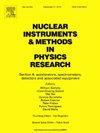Radiation-resistant thin LGADs for enhanced 4D tracking
IF 1.5
3区 物理与天体物理
Q3 INSTRUMENTS & INSTRUMENTATION
Nuclear Instruments & Methods in Physics Research Section A-accelerators Spectrometers Detectors and Associated Equipment
Pub Date : 2025-07-17
DOI:10.1016/j.nima.2025.170799
引用次数: 0
Abstract
This contribution presents the results of an R&D study on the EXFLU1 batch, a novel concept of thin Low Gain Avalanche Diodes (LGADs) designed to achieve improved timing resolution and radiation tolerance up to 25 × 1014 ncm−2. Sensors with different thicknesses (15, 20, 30, and ) have been explored. New designs for the gain layer and guard ring structure have been investigated, along with two different doping activation methods. The sensors have been irradiated up to 25 × 1014 ncm−2 and characterised in terms of current, capacitance, and gain to assess their radiation tolerance. Finally, LGADs were tested in a 4 GeV electron beam to evaluate their timing resolution.
抗辐射薄lgad,增强4D跟踪
这篇文章介绍了EXFLU1批次的研发研究结果,EXFLU1批次是一种新颖的薄型低增益雪崩二极管(lgad)概念,旨在实现提高的定时分辨率和高达25 × 1014 neqcm−2的辐射容限。不同厚度的传感器(15、20、30和45μm)已经被探索。研究了增益层和保护环结构的新设计,以及两种不同的掺杂激活方法。传感器的辐照强度可达25 × 1014 neqcm - 2,并根据电流、电容和增益进行表征,以评估其辐射耐受性。最后,在4 GeV电子束下对30μm LGADs进行了时序分辨率测试。
本文章由计算机程序翻译,如有差异,请以英文原文为准。
求助全文
约1分钟内获得全文
求助全文
来源期刊
CiteScore
3.20
自引率
21.40%
发文量
787
审稿时长
1 months
期刊介绍:
Section A of Nuclear Instruments and Methods in Physics Research publishes papers on design, manufacturing and performance of scientific instruments with an emphasis on large scale facilities. This includes the development of particle accelerators, ion sources, beam transport systems and target arrangements as well as the use of secondary phenomena such as synchrotron radiation and free electron lasers. It also includes all types of instrumentation for the detection and spectrometry of radiations from high energy processes and nuclear decays, as well as instrumentation for experiments at nuclear reactors. Specialized electronics for nuclear and other types of spectrometry as well as computerization of measurements and control systems in this area also find their place in the A section.
Theoretical as well as experimental papers are accepted.

 求助内容:
求助内容: 应助结果提醒方式:
应助结果提醒方式:


